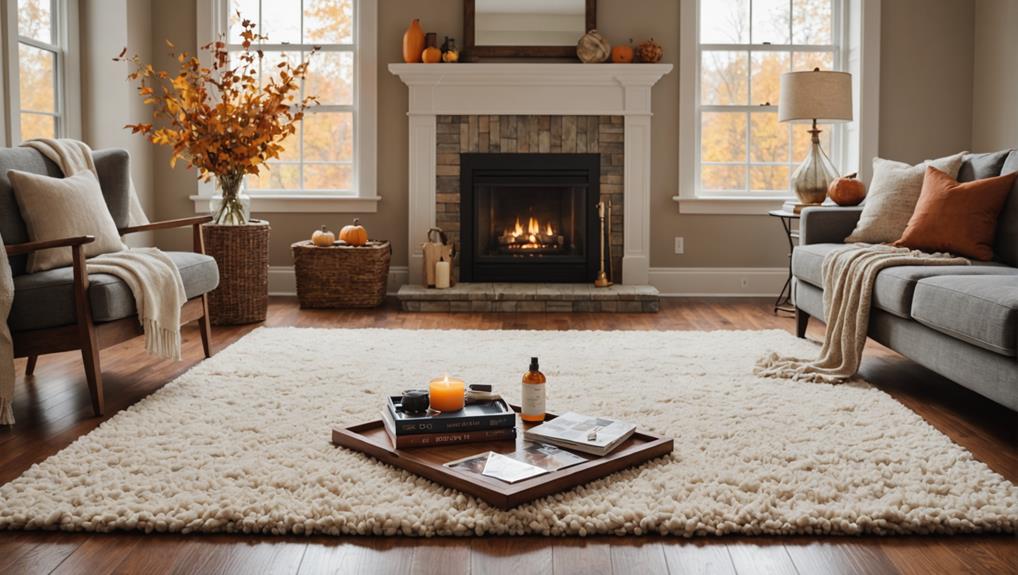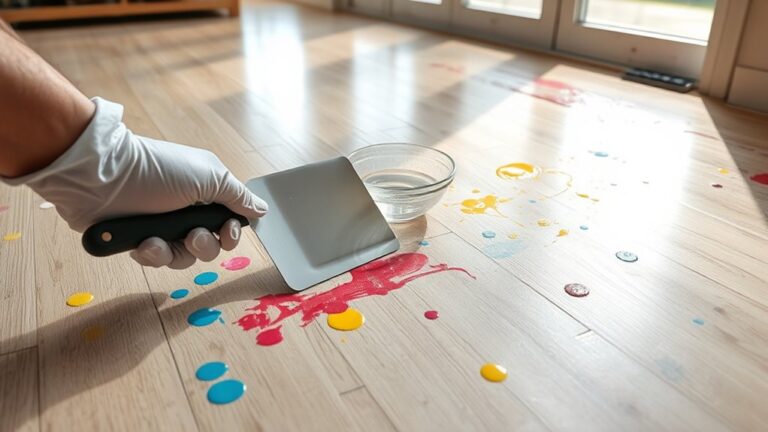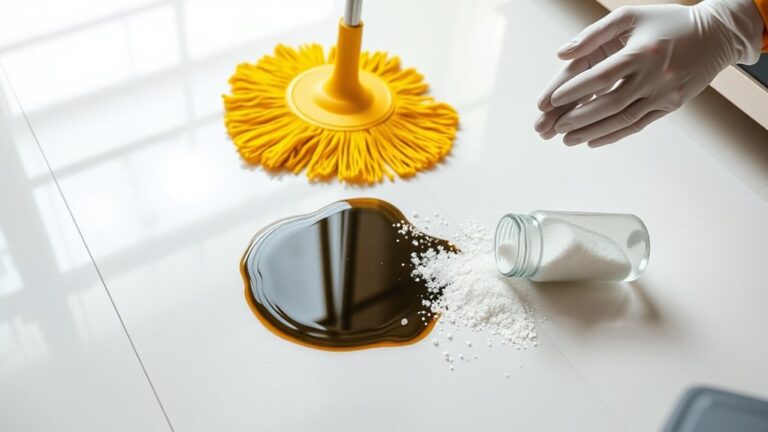For effective fall maintenance of your hardwood floors, start by inspecting for scratches and moisture damage. Regular cleaning is essential; dust daily and perform a weekly deep clean using a microfiber mop and eco-friendly solutions. Control humidity levels between 30% and 50% to prevent warping, and consider using dehumidifiers if needed. Place protective mats at entryways to trap dirt and moisture while using area rugs in high-traffic zones for added protection. Assess whether your floors need refurbishing or a fresh coat, ensuring long-lasting beauty and durability. Explore additional strategies to keep your hardwood floors in pristine condition effectively.
Ispezionare per danni
Before jumping into cleaning and maintenance, it's important to thoroughly inspect for damage on your hardwood floors. Start by examining the surface for any visible surface scratches. These can occur due to everyday wear or can be a result of moving furniture without protective pads. Identifying these scratches early allows you to determine whether they can be addressed with a simple buffing or if more extensive refinishing is necessary.
Next, pay close attention to areas that may have been exposed to moisture. Look for signs of moisture damage, such as warping, discoloration, or swelling in the wood. It's vital to check around entryways, kitchens, and bathrooms where spills or humidity might be more common. If you spot any areas affected by moisture, take immediate action to mitigate further damage. This may involve drying the area thoroughly and monitoring it for any signs of mold or mildew.
As you conduct your inspection, don't forget to assess the integrity of the floor's finish. A compromised finish can lead to more significant issues over time, including deeper scratches and increased vulnerability to moisture damage. If you notice any areas where the finish appears worn or dull, it may be time to reflect on refinishing the floors to restore their protective layer.
Clean Regularly
To maintain the integrity of your hardwood floors, regular cleaning is essential. You should implement daily dust removal, weekly deep cleaning, and seasonal polish application to keep your floors looking their best. Each step plays a vital role in prolonging the life and appearance of your hardwood surfaces.
Daily Dust Removal
Dust and debris can accumulate quickly on hardwood floors, making daily dust removal essential for maintaining their beauty and longevity. To effectively keep your floors clean, consider employing the right vacuum techniques and dusting tools. A vacuum with a hardwood floor attachment is ideal, as it minimizes the risk of scratches while efficiently removing dirt and particles.
When vacuuming, make certain you use low suction settings to prevent any damage to the wood. It's also important to regularly check and clean the vacuum's brush roll to avoid transferring dirt back onto the floor. If you prefer dusting tools, microfiber mops or cloths are excellent choices, as they trap dust instead of pushing it around, providing a safer cleaning option.
In addition to your chosen method, establish a routine that fits your lifestyle. Aim to remove dust and debris daily, particularly in high-traffic areas. This not only preserves the finish of your hardwood floors but also contributes to a healthier indoor environment by reducing allergens. By consistently practicing daily dust removal, you'll make certain your hardwood floors remain stunning and durable for years to come.
Pulizia profonda settimanale
Incorporating a routine for weekly deep cleaning can greatly enhance the appearance and lifespan of your hardwood floors. To begin, gather suitable cleaning tools, including a microfiber mop, a soft-bristle broom, and a vacuum cleaner with a hardwood floor attachment. These tools are essential for removing dirt and debris without scratching the surface.
Next, opt for eco-friendly solutions that are safe for both your floors and the environment. A simple mixture of warm water and white vinegar can effectively clean your hardwood floors without harmful residues. Avoid harsh chemicals that may damage the finish or leave toxic residues.
Start your deep cleaning by sweeping or vacuuming any loose dirt and dust. Following that, dampen your microfiber mop with the eco-friendly solution and gently mop the floor, ensuring it's not overly wet. Excess moisture can cause warping or damage to the wood.
Seasonal Polish Application
After completing your weekly deep cleaning, it's important to contemplate the seasonal application of polish to maintain the luster and protection of your hardwood floors. Regular polishing not only enhances the aesthetic appeal but also provides a protective barrier against scratches and moisture, which can be particularly pertinent during fall when debris and humidity levels fluctuate.
When considering polish techniques, you'll want to select a product specifically formulated for hardwood floors. Water-based polishes are generally safer and less toxic, making them ideal for indoor use. Verify the area is well-ventilated during application to minimize any potential fumes.
As you apply the polish, follow the manufacturer's guidelines for best results. Use a microfiber mop to distribute the polish evenly, which helps avoid streaks and buildup. Pay attention to seasonal trends in your area—higher foot traffic from autumn activities may necessitate more frequent applications to keep your floors looking pristine.
Ultimately, a well-executed seasonal polish application will not only prolong the life of your hardwood floors but also enhance your home's safety and aesthetic during the fall months.
Control Humidity Levels
Controlling humidity levels is essential for maintaining the integrity of your hardwood floors. Ideally, you should aim for a humidity range of 30% to 50% to prevent issues like warping and cracking. Utilizing a dehumidifier can effectively help you achieve and maintain this balance, ensuring the longevity of your pavimentazione.
Ideal Humidity Range
Maintaining the ideal humidity range in your home is vital for the longevity of hardwood floors, as fluctuations can lead to warping or cracking. Ideally, you should aim for a humidity level between 30% and 50%. This moisture balance is critical; too little humidity can cause the wood to dry out, while excessive moisture can lead to swelling and structural damage.
To achieve effective humidity control, regularly monitor your indoor humidity levels with a hygrometer. If you find that levels are consistently outside the ideal range, consider adjusting your home's climate. During fall, as temperatures drop, indoor humidity may decrease, making it necessary to introduce moisture back into the air.
You might use a humidifier, particularly in dry climates or during cold weather, to maintain that desired moisture balance. Conversely, if humidity levels rise, facilitate proper ventilation to prevent moisture buildup. This proactive approach helps protect your hardwood floors from potential damage, guaranteeing they remain beautiful and functional for years to come. By prioritizing humidity control, you're investing in the long-term health of your hardwood flooring.
Dehumidifier Benefits
Investing in a dehumidifier can greatly enhance your ability to control humidity levels in your home, especially during the fall months when moisture can fluctuate. Maintaining ideal humidity not only protects your hardwood floors but also contributes to a healthier indoor environment. A dehumidifier's efficiency in removing excess moisture can considerably reduce the risk of mold growth, which could compromise both your flooring and your health.
When choosing a dehumidifier, look for models that offer adjustable settings, allowing you to fine-tune humidity control based on real-time readings. This capability guarantees that your living space remains within the perfect humidity range of 30-50%. By effectively managing moisture levels, you can prevent wood from warping or cracking, preserving the integrity of your floors.
Moreover, a dehumidifier can improve overall air quality by filtering out allergens and pollutants. Regularly monitoring and adjusting your humidity levels with a dehumidifier not only safeguards your hardwood floors but also promotes a safer, more comfortable home environment. As the seasons change, consider how a dehumidifier can be an invaluable tool in your fall maintenance routine.
Utilizzare tappetini protettivi
One effective way to protect your hardwood floors during the fall is by using protective mats. These mats serve as a barrier against dirt, moisture, and debris that can accumulate as the seasons change, especially with leaves, rain, and mud. Choosing the right mats material is essential to guarantee they effectively shield your floors while blending with your home's decor.
When selecting and placing your mats, consider the following:
- Entry Points: Position mats at all entryways to capture dirt and moisture before it spreads onto your hardwood floors. Look for mats made of rubber or coir, as these materials trap debris effectively.
- High-Traffic Areas: Identify areas in your home that receive heavy foot traffic, such as hallways and living rooms. Use larger mats in these spaces to provide ample coverage, reducing wear and tear on your floors.
- Under Furniture: It's also wise to place mats under furniture that may be moved around frequently. This prevents scuffs and scratches from dragging furniture across the floor.
Proper mat placement not only protects your hardwood floors but also enhances safety by reducing slippage caused by wet surfaces. Regularly clean and maintain your mats to guarantee they remain effective in safeguarding your floors. By integrating protective mats into your fall maintenance routine, you'll preserve the beauty and integrity of your hardwood floors throughout the season.
Refurbish and Refinish
While protective mats are effective for day-to-day maintenance, refurbishing and refinishing your hardwood floors can rejuvenate their appearance and prolong their lifespan. This process involves several steps, including selecting appropriate sanding techniques and choosing the right stain for your desired finish. Proper execution guarantees not only aesthetic enhancement but also the safety and longevity of your floors.
To begin, assess your hardwood floors' current condition. If they show signs of wear, scratches, or discoloration, it may be time for refurbishing. Depending on damage severity, you might opt for a light sanding or a more intensive sanding process. Here's a quick overview:
| Sanding Technique | Ideale per | Safety Tips |
|---|---|---|
| Light Sanding | Minor scratches and scuffs | Wear a mask; guarantee good ventilation |
| Medium Sanding | Moderate wear | Use safety goggles; keep children away |
| Heavy Sanding | Deep scratches or stains | Guarantee proper equipment; follow manufacturer guidelines |
Once you've selected the sanding technique, choose your stain selection carefully. The stain not only enhances the wood's natural beauty but also adds a layer of protection. Make sure to test a small area first to guarantee the color meets your expectations.
Apply a Fresh Coat
After sanding your hardwood floors, applying a fresh coat of finish is crucial for sealing and protecting the wood. This step not only enhances the appearance of your floors but also prolongs their lifespan. Choosing the right finish and color options can greatly impact the final look, so it's important to take into account your preferences and the environment of your space.
Here are three key steps to apply a fresh coat effectively:
- Select the Finish: Decide between oil-based and water-based finishes. Oil-based finishes tend to be more durable and provide a rich, amber hue, while water-based options dry faster and emit fewer fumes, making them safer for indoor use.
- Choose Staining Techniques: If you want to change the color of your hardwood, employ staining techniques before applying the finish. You can opt for a traditional stain application or a rag method for a more controlled look. Always test a small area first to confirm you're satisfied with the result.
- Application Process: Use a high-quality applicator, such as a foam roller or brush. Apply the finish in thin, even coats, following the grain of the wood to avoid streaks. Allow adequate drying time between coats, usually 24 hours, to guarantee a strong bond.
Domande frequenti
How Often Should I Clean My Hardwood Floors in Fall?
You should clean your hardwood floors regularly during fall cleaning to maintain their integrity and appearance. It's best to do a thorough cleaning every one to two weeks, depending on foot traffic. Use a gentle cleaner specifically designed for hardwood care to avoid damage. Always guarantee the floors are dry afterward to prevent slips and water damage. Regular maintenance not only enhances safety but also prolongs the life of your hardwood floors.
Can I Use Vinegar for Cleaning Hardwood Floors?
You might be tempted to use vinegar for cleaning hardwood floors due to its natural cleaning benefits, but it's not recommended. While vinegar can effectively cut through grime, its acidity can damage the finish over time. Instead, consider using pH-balanced cleaning solutions specifically designed for hardwood. These products are safer and protect your floor's integrity, ensuring a longer lifespan. Always follow manufacturer guidelines for the best results in maintaining your hardwood floors.
What Type of Mat Is Best for Protecting Hardwood Floors?
Did you know that nearly 80% of hardwood floor damage comes from moisture and dirt? To protect your hardwood floors, investing in high-quality floor mats with moisture barriers is crucial. Look for mats made of rubber or vinyl, as they effectively trap moisture and prevent it from seeping into the wood. Make sure they're also slip-resistant to provide safety in high-traffic areas, helping to maintain your floors' integrity while keeping your home safe.
How Do I Remove Scratches From Hardwood Floors?
To remove scratches from hardwood floors, start with scratch repair kits that match your floor's finish. Clean the area thoroughly, then apply the repair solution as directed. For deeper scratches, you might consider hardwood refinishing, which involves sanding and applying a new finish. Always test any product in an inconspicuous area first to verify compatibility. Remember to wear safety gear, like gloves and a mask, to protect yourself during the process.
Is It Safe to Use Steam Cleaners on Hardwood Floors?
Using a steam cleaner on hardwood floors might seem like a quick fix, but it can lead to damage. While steam cleaners are effective for some surfaces, hardwood floor care requires caution. The intense heat and moisture can warp or weaken the wood, compromising its finish. For steam cleaner safety, it's best to avoid them altogether on hardwood. Instead, opt for gentler cleaning methods that preserve your floors while ensuring they stay beautiful.




